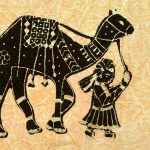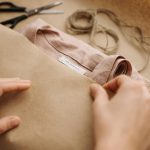You’ll love camel hair fabric for its exceptional warmth and lightweight insulation, thanks to hollow fibers that trap air while letting moisture escape. It feels incredibly soft against your skin, with a smooth texture that avoids itchiness. Durable and elegant, camel hair naturally wicks sweat and breathes well, keeping you comfortable in various climates. Plus, it’s renewable and eco-friendly when sourced responsibly. Keep exploring to discover how this fabric enhances fashion and home textiles.
Table of Contents
Key Takeaways
- Camel hair fabric is made from the soft undercoat of Bactrian camels, harvested sustainably during natural shedding.
- Its hollow fiber structure provides lightweight insulation and excellent moisture-wicking for temperature regulation and comfort.
- The fabric is ultra-soft, durable, and flexible, with a smooth texture that minimizes irritation and adds natural sheen.
- Camel hair is renewable, biodegradable, and has a lower environmental impact compared to other livestock fibers.
- It is versatile, ideal for elegant fashion garments and warm, durable home textiles like throws and upholstery.
Origin and Source of Camel Hair
Although camel hair might seem exotic, it actually comes from a straightforward source: the soft undercoat of camels. When camels shed their winter coats in spring, you can collect the fine, downy fibers that make up this undercoat.
You’ll find that camel hair is harvested mostly from Bactrian camels, native to Central Asia. Unlike the coarse outer hair, the undercoat is incredibly soft and fine, making it perfect for fabric production.
You don’t have to worry about harming the animals because the hair is usually gathered through combing or natural shedding. This renewable process guarantees a sustainable supply.
Natural Warmth and Insulation Properties
Beyond its sustainable sourcing, camel hair fabric offers remarkable natural warmth and insulation.
When you wear garments made from camel hair, you benefit from the fiber’s unique hollow structure, which traps air and retains body heat efficiently. This natural insulation keeps you warm without adding bulk, making it perfect for chilly days.
Camel hair’s hollow fibers trap warmth efficiently, providing lightweight, natural insulation perfect for chilly days.
Unlike synthetic materials, camel hair regulates temperature by allowing moisture to escape, so you stay comfortable without overheating or feeling damp.
Its lightweight yet insulating properties mean you can layer less and still stay cozy.
Whether you’re outdoors or in a cool indoor setting, camel hair fabric adapts to your body’s needs, providing reliable warmth that’s both breathable and effective throughout the day.
Softness and Texture Profile
Softness defines much of camel hair fabric’s appeal, offering a gentle touch that feels luxurious against your skin. When you wear camel hair, you immediately notice its smooth, fine fibers, which create a cozy, comforting texture. Unlike some coarse wools, camel hair remains soft and pliable even after prolonged use. Its natural fiber structure also provides a subtle sheen, adding to the fabric’s refined appearance.
| Feature | Description | Benefit |
|---|---|---|
| Fiber Diameter | 16-20 microns | Ultra-soft feel |
| Surface Texture | Smooth, fine scales | Minimal itch or irritation |
| Fiber Length | 70-100 mm | Durable yet soft fabric |
| Natural Sheen | Light reflective property | Elegant and luxurious look |
| Flexibility | High | Comfortable wear and drape |
Moisture-Wicking and Breathability Features
When you wear camel hair fabric, you’ll notice it manages moisture exceptionally well, keeping you dry and comfortable throughout the day.
The natural fibers have excellent moisture-wicking properties, pulling sweat away from your skin and allowing it to evaporate quickly. This helps regulate your body temperature, so you won’t feel clammy or overheated.
Additionally, camel hair’s breathable structure lets air circulate freely, enhancing comfort whether you’re indoors or outside.
Unlike synthetic materials that trap heat and moisture, camel hair keeps you fresh by maintaining a balanced environment around your skin.
Whether you’re active or at rest, this fabric supports natural ventilation, making it ideal for various climates and activities.
You’ll appreciate its ability to keep you cool and dry without sacrificing softness.
Durability and Strength of Camel Hair Fabric
Although camel hair fabric feels incredibly soft, it doesn’t compromise on durability. When you wear or use camel hair, you benefit from fibers that are naturally strong and resilient.
This fabric resists wear and tear better than many other natural fibers, so your garments last longer without losing their shape. You’ll find that camel hair holds up well against daily use, making it ideal for outerwear and heavy garments.
Its durability also means it withstands frequent cleaning without significant damage. Plus, the fabric’s unique fiber structure provides strength while maintaining flexibility, so you won’t feel restricted.
Choosing camel hair means you get a blend of comfort and toughness that stands the test of time.
Color and Dyeing Characteristics
When you work with camel hair fabric, you’ll notice its natural color varies from light tan to rich brown, giving each piece unique character.
You’ll also find it absorbs dyes well, allowing for vibrant and lasting colors. Understanding these traits helps you choose the perfect shade for your project.
Natural Color Variations
Since camel hair naturally comes in a range of earthy tones—from light beige to rich brown—you’ll find its color variations both subtle and appealing.
These natural hues give camel hair fabric a warm, classic look without needing heavy processing. You’ll notice that each fiber carries slight differences in shade, adding depth and texture to the finished fabric.
This inherent variety means the material often has a softly mottled appearance, which enhances its visual interest. When you work with camel hair fabric, you’ll appreciate how its natural colors complement both casual and formal styles.
Plus, because of its natural pigmentation, the fabric resists fading, maintaining its beauty over time even with regular wear. This makes camel hair a timeless choice for your wardrobe.
Dye Absorption Qualities
The natural color variations in camel hair set a strong foundation for understanding how the fabric interacts with dyes. When you dye camel hair, you’ll notice it absorbs colors differently than other fibers.
Its natural oils and structure allow dyes to penetrate deeply, resulting in rich, vibrant hues. However, because camel hair ranges from light tan to deep brown, the final color can vary depending on the original shade. You might find that lighter shades brighten easily, while darker tones absorb dyes more subtly.
Also, camel hair holds onto dye well, so colors tend to stay vivid longer without fading quickly. If you want consistent results, pre-treating the fabric or choosing dyes suited for animal fibers will help you achieve the best outcome.
Environmental Sustainability and Ethical Considerations
Although camel hair fabric offers natural warmth and durability, you should consider its environmental and ethical impacts before choosing it. Camel hair is renewable and biodegradable, but the farming methods and animal treatment vary widely. Supporting sustainable practices guarantees minimal habitat disruption and humane care. You can reduce your environmental footprint by choosing certified sources.
| Aspect | Benefits | Considerations |
|---|---|---|
| Renewability | Sheared annually, regrows | Overharvesting risks |
| Biodegradability | Breaks down naturally | Chemical dyes may hinder this |
| Animal Welfare | Generally humane when regulated | Poor treatment in unregulated farms |
| Land Use | Low impact compared to livestock | Overgrazing concerns |
| Carbon Footprint | Lower than synthetic fibers | Transportation emissions |
Applications in Fashion and Apparel
When you choose camel hair fabric, you tap into a material prized for its exceptional warmth, softness, and durability—qualities that designers value highly in fashion and apparel.
You’ll find camel hair perfect for crafting luxurious coats, jackets, and scarves that provide comfort without bulk. Its natural insulation keeps you warm in cold weather, while its breathable texture prevents overheating.
Because camel hair drapes beautifully, it lends itself well to elegant suits and tailored garments, adding both style and function. Plus, its subtle sheen and rich tones bring a timeless appeal to your wardrobe.
Whether you’re aiming for casual or formal wear, camel hair fabric offers versatility and sophistication that helps your pieces stand out season after season.
Uses in Home Textiles and Interior Design
Warmth and elegance make camel hair fabric an excellent choice for home textiles and interior design.
When you want to add a cozy yet sophisticated touch to your living space, camel hair offers durability and a natural, luxurious feel.
You can transform your home by incorporating it in various ways:
- Throws and Blankets – Perfect for adding warmth and texture to your sofa or bed.
- Upholstery – Use camel hair for chairs or cushions to bring softness and resilience.
- Curtains and Drapes – Enhance your windows with camel hair fabric to create an inviting atmosphere while maintaining insulation.
Frequently Asked Questions
How Should Camel Hair Fabric Be Properly Cleaned and Maintained?
Did you know camel hair garments can last decades if cared for properly? You should dry clean camel hair fabric, avoid washing it yourself, and store it in a cool, dry place to keep it looking sharp.
What Are the Common Misconceptions About Camel Hair Fabric?
You might think camel hair fabric is itchy or hard to clean, but it’s actually soft and durable. Also, it’s not as expensive or rare as people assume, making it a practical, stylish choice.
Can Camel Hair Fabric Cause Allergies or Skin Irritation?
You might experience allergies or skin irritation if you’re sensitive to animal fibers, but camel hair fabric is usually gentle. Always test a small area first, especially if you have sensitive skin or wool allergies.
How Does Camel Hair Fabric Compare Cost-Wise to Other Luxury Fabrics?
You’ll find camel hair fabric generally costs more than many luxury fabrics due to its rarity and labor-intensive processing. It’s pricier than wool or cashmere but offers unique warmth and softness that justifies the investment.
What Is the Historical Significance of Camel Hair in Textile Production?
You’ll find camel hair’s historical significance rooted in ancient nomadic cultures, where it provided warmth and durability. It’s been prized for centuries, symbolizing luxury and practicality in textile production across harsh climates worldwide.
- Does Chiffon Fabric Stink - July 15, 2025
- Does Chiffon Fabric Affect the Economy - July 15, 2025
- Does Cotton Fabric Have a Nap - July 15, 2025







